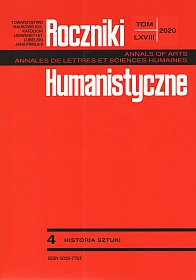Między ideą a konstrukcją. Projekty ołtarzy Jana Matejki
Between idea and construction. Jan Matejko’s altarpiece designs
Author(s): Barbara CicioraSubject(s): Fine Arts / Performing Arts, Visual Arts, History of Art
Published by: Towarzystwo Naukowe KUL & Katolicki Uniwersytet Lubelski Jana Pawła II
Keywords: Jan Matejko; Władysław Łuszczkiewicz; Józef Łepkowski; historicism; neo-Gothic altarpieces; restoration of monuments; Wit Stwosz’s altarpiece; principle of unity of style; renovation of Wawel crypts
Summary/Abstract: The article concerns the reception of medieval altarpieces by the most significant Polish history painter, Jan Matejko. That was used for a creation of new works of art based upon historical forms (but not stylistic) that were derived from real historical monuments. Matejko was interested neither in contemporary pattern books for architects nor in reconstructions done according to imagined vision of style, mainly Gothic, which was proposed by restorers like Carl Heideloff or Eugène-Emmanuel Viollet-le-Duc. He gained his knowledge about real, existing medieval altarpieces during his journeys in Poland and abroad, which he took in his youth, and also through his participation in restorations of medieval monuments in Kraków, first of all – the Gothic altarpiece by Wit Stwosz in Mariacki church. Thanks to these experience he got to know a construction of altarpieces and details such as the types of medieval figures, their costumes, weapons, crafts, but also stylistic features that were not well recognized by restorers’ environment in Kraków. Additionally, that verified two types of the reception of the Middle Ages. One, philosophical and emotional, characteristic for Romanticism and propagated by the philosopher and art lover Józef Kremer and the second, characteristic for the artist, restorer and one of the first historians of art, Władysław Łuszczkiewicz that criticized artistic realisations done ages ago from the contemporary point of view. Repairing old and designing new altarpieces was a difficult task for Matejko as very often he was confronted by different points of view on restoration. The most discouraging was a dispute between followers of the unity of style (Józef Łepkowski, Władysław Łuszczkiewicz) and their opponents who appreciated the original form of the monument, including later elements from different epochs (Piotr Michałowski, Paweł Popiel, Stanisław Tomkowicz). Then Matejko’s work was located between verification of ideas of restoration, models of writing about art, opinions about style of monuments on one side and the analytical research on an external appearance and features of construction of local objects on the other side. Neither his knowledge, experience trained thanks to deep and critical observations and comparisons of historic works of art – but, unfortunately, without a support in an authority of restoration theories done by western historians of art and architecture – nor his designs, did not gained respect in Krakow among people concentrated on theoretical opinions on restoration and on ideas concerning forms and meaning of the monuments in Krakow.
Journal: Roczniki Humanistyczne
- Issue Year: 68/2020
- Issue No: 4
- Page Range: 79-124
- Page Count: 46
- Language: Polish

